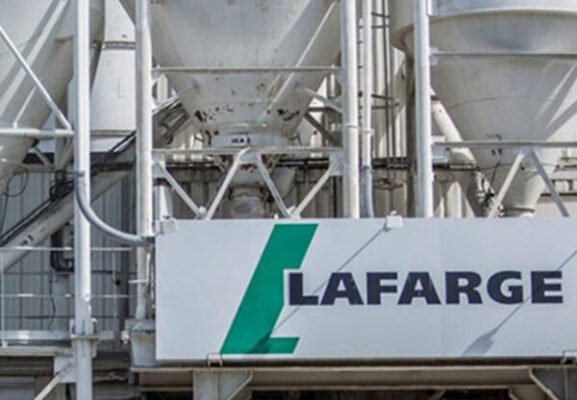Greyish dust covers what would normally be green tree leaves as well as other surrounding surfaces in what serves as testimony to the environmentally toxic activities caused by Lafarge- a cement production plant- in Mabvuku.
From a distance, even on a scorching Zimbabwean summer day, a white cloud of excessive dust emitted from the plant can be seen hovering over the residential area.
This has made life here “an unbearable living hell” according to the residents. Cement dust hovering above Mabvuku residential area, a result of emissions from Lafarge’s cement making plant.
“We are strangers to fresh air and we never open our windows for ventilation to prevent dust from settling on furniture and linen, says Kelvin Nhatau (27), who was born and raised here.
“If I skip a day without cleaning the house, all things are bound to turn grey.”
The problems do not end there as Lafarge’s activities come with more than air contamination but also tormenting noise pollution.
“We also have noise produced from the plant to grapple with daily. There is no rest, it’s only that we have adapted but during our first days here getting some sleep was very hard,” he added.
With the United Nations Environment Programme (UNEP) reporting that air pollution kills over six million people each year through strokes, lung cancer, heart attacks and respiratory diseases, the industrial activity has presented a health dilemma for most of Mabvuku resident
From a distance, evident low visibility conditions from dust emitted by Lafarge cement plant Seventy-eight year-old Eunika Kanhukamwe who has been staying in the area since 2001 expressed discomfort over the emissions saying they have made her cough since the day she moved into Mabvuku.
“I always have a mild cough and this has been the case since moving here back in 2001,” she says.
In a show of penitence for the business negative impact on the environment, residents say the former owners of the plant before Lafarge took over two decades ago, would parcel out pints of milk to each household to mitigate effects of inhaled dust
“Back in the day when the plant was under Circle Cement, we would get portions of milk three times a week among other development initiatives carried out in the neighbourhood, as show of admittance to the health risk they were exposing us to, Nhatau revealed.
Although medical scholars have dismissed claims that milk can mitigate respiratory challenges for a myth, residents feel hard done by Lafarges careless conduct.
“Ever since Lafarge took over, we have barely seen any form of development they have brought to this community. We have dust roads around this area but no attempt whatsoever has been made to at least x them.
“If infrastructural development is too much to ask for, how about at least supplying us with dust masks to protect us from the dust they feed us every day and night,” lamented Nhatau.
Further illustrations by Mabvuku residents detailed how removing the dust that would have settled on windscreens of vehicles after a few days can leave one cringing over the thought of impact the same dust would have within the human respiratory system.
Water alone, they say, could not clear o the settling dust calling for a homegrown solution of sprinkling vinegar on the screen to clear it off.
Meanwhile, Lafarge was last week ordered to stop operations following complaints led by residents to the Environmental Management Agency (EMA) over dust emissions at the plant.
The agency observed that the plant was repeatedly discharging dust emissions that are abnormal and generating fugitive dust from the kiln stack and the surrounding plant. To that end, an order was served to Lafarge to cease operations at the kiln stack until all areas of concern have been rectified to the satisfaction of the agency, EMA environmental education and publicity manager Amkela Sidange sai
According to Sidange, operations only resumed following laborious meetings with the cement maker which came up with strict conditions.
Following rigorous engagements and considerations, the agency has since made a variation to the order by allowing Lafarge Cement to resume kiln stack operations but under very strict conditions; and to comply with the conditions of the initial order served.
One of the conditions is that Lafarge should submit to the agency after every 14 days, returns detailing the daily average concentration of dust emissions from the kiln following the commencement of the operations, including fall out dust at locations to be set up in consultation with the agency,” she said.
But residents who spoke to this publication say there was never a sign of stopped operations at the plant.
“Not at any time last week do we remember that noise muting or that chimney emitting little to no dust, it was business as usual, said a group of women residing a few meters away from the plant in unison.
Despite the allegations, Lafarge said in a statement: We received a directive from the authority to stop operations earlier in the week and we immediately complied. After this, EMA officials came to our site to conduct investigations after which the directive was reviewed subject to the company fulfilling a set of conditions.
A report by the International Association for Medical Assistance to Travellers (IAMAT) says
Zimbabwe’s air quality is considered moderately unsafe per the World Health Organization’s guidelines.
The report attributes Zimbabwe’s poor air quality to mining, cement and steel industries, fertilizer manufacturing, vehicle emissions, and waste burning.
263Chat
.png)




